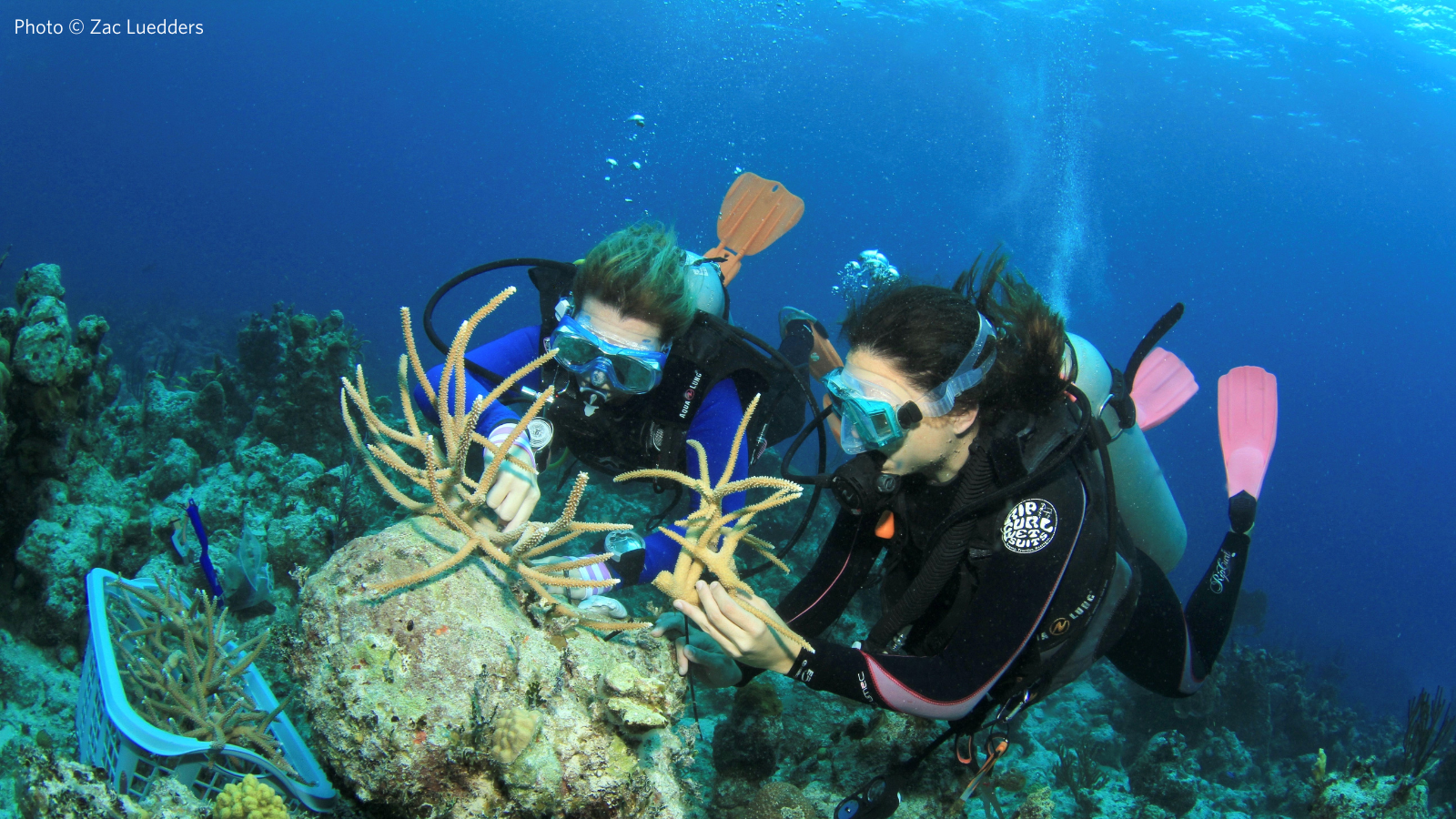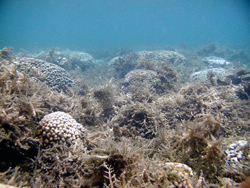Article Summaries
The Reef Resilience Network compiles summaries of recent scientific publications that are relevant to marine managers who are working to build or improve the resilience of their reefs. This includes articles that address the impacts of global climate change, other stressors at local scales, and building resilience into daily management activities. Explore by scrolling through the list below or using the search feature on the left. Please contact us at resilience@tnc.org if you have an idea for an article summary or can’t find an article you were expecting to find.
-
 Suggett et al. 2024The authors highlight the difference between "ecological restoration" (hands-on recovery efforts) and "restoration ecology" (the science behind these efforts). They recommend integrating restoration into a...
Suggett et al. 2024The authors highlight the difference between "ecological restoration" (hands-on recovery efforts) and "restoration ecology" (the science behind these efforts). They recommend integrating restoration into a... -
 Smith et al. 2023This low-tech, high-impact method can be integrated into local reef management strategies and can be done using volunteer divers with minimal training.
Smith et al. 2023This low-tech, high-impact method can be integrated into local reef management strategies and can be done using volunteer divers with minimal training. -
 Baker et al. 2023Marine protected areas (MPAs) are vital tools for safeguarding ecological systems and are increasingly being established worldwide. However, MPAs can significantly impact human well-being, particularly...
Baker et al. 2023Marine protected areas (MPAs) are vital tools for safeguarding ecological systems and are increasingly being established worldwide. However, MPAs can significantly impact human well-being, particularly...
Gudka et al. 2024
Coral reefs are increasingly threatened by various disturbances, making it essential for managers to identify which reefs are more resilient and capable of retaining their biodiversity and ...
Jagadish et al. 2024
Recent studies and the Global Biodiversity Framework underscore the vital role of management initiatives led by Indigenous Peoples (IP) and Local Communities (LC) in achieving conservation ...
Walker et al. 2024
With marine heatwaves increasing in frequency and intensity, it is necessary to understand coral recovery post-disturbance. This study examined coral cover recovery rates across 1,921 sites in ...
Lyons et al. 2024
High-resolution spatial data on coral reef distribution and composition can help managers and researchers plan marine conservation efforts, better predict climate change impacts, and enhance ...
Climate change poses a significant threat to coral reefs worldwide, necessitating efforts to identify and promote local conditions that enhance resilience in the short term. While it is known ...
Climate change poses challenges for designing and managing marine protected areas (MPAs). The review examined 172 management plans covering 555 MPAs across 52 countries to see how well existing ...
Several challenges impede marine conservation efforts in promoting social equity, including historical Western-focused conservation models with a top-down approach and insufficient consideration ...
Area-based management for conserving biodiversity is becoming more common, especially to meet global targets like the 30 X 30 initiative. While Marine Protected Areas (MPAs) are often set up to ...
Local human activities and climate-driven marine heatwaves are significantly altering coral reef ecosystems. Managers aiming to increase reef resilience often face challenges in effectively ...
Historically, natural resource management has focused on preserving or restoring ecosystems to previous baseline conditions. However, intensifying anthropogenic impacts combined with climate ...
Marine heatwave stress has led to widespread coral bleaching and mortality events. The ability of reef-building corals to withstand this heat stress will be an important trait under natural ...
To mitigate the impacts of pollutants on coral reef ecosystems, managers require data-driven water quality thresholds. This study conducted a comprehensive review and meta-analysis, assessing ...
Coral reef ecosystems and reef fish populations worldwide are diminishing due to a combination of factors, including overfishing, climate change, deteriorating water quality, habitat ...
Human activities in coastal regions, such as mining, farming, urbanization, and waste disposal, deteriorate water quality in nearby watersheds, negatively impacting downstream coastal ecosystems ...
This study revealed that an acute deoxygenation event on a Caribbean coral reef rapidly altered the benthic community composition and microbial assemblage present. The deoxygenation event led to ...
This study assessed the coral community composition, bleaching, and mortality across a gradient of anthropogenic disturbance levels before, during, and after a prolonged heatwave during the ...
Coral reef restoration projects are becoming a popular corporate environmental responsibility activity at hotel resorts. This paper presents a simple monitoring method that hotel staff can ...
Coral reefs are at risk due to coral bleaching caused by warming ocean temperatures and extreme heat waves, but certain coral populations exhibit tolerance to elevated temperatures. In Palau, ...
Integrating Resilience into Coral Reef Restoration
For context:
“An ‘other effective area-based conservation measure’ is defined by the CBD as: A geographically defined area other than a Protected Area, which is governed and managed in ways ...
The authors of this study convened coral reef experts to outline a set of principles that could be undertaken as a coordinated strategy to sustain coral reefs into the future. Through a new ...
This study analyzed coral reefs in the southeastern Dominican Republic area of Bayahibe from 2011-2016, where tourism activities have increased significantly in recent years. These reefs, ...
In recent decades, marine heatwaves have caused widespread coral mortality, altering the structure of reef communities that people rely on for critical ecosystem services. Though some studies ...
This year-long study measured sucralose, nitrogen isotopes in macrophytes, aqueous nutrients, and C-44 measurements in groundwater systems vulnerable to septic leaking from canals and nearshore ...
This study measured water and environmental characteristics to determine the conditions more suitable for corals providing managers in the area with a baseline and goal for coral conservation. ...
This is the first report of the impacts of sewage pollution on coral reefs in Belize, which were classified as poor by the Healthy Reefs evaluation. There has been extensive coastal development ...
This paper explores the correlations between water quality (measured concentrations of nutrients, metals, and organic compounds), Amphistegina gibbosa (a bioindicator species in the area), and ...
This study focuses on Tolo Harbour in Hong Kong that experiences limited flushing and low salinity. Development since 1973 has led to increased sewage discharge and a pollution gradient within ...
This study explores the efficacy, or lack thereof, of no-take reserves to effectively reduce coral disease and loss, identifying land-based pollution, particularly nutrients, as a persistent ...
This paper identified the lack of understanding of the ability to use macroalgae as an indicator of water and ecosystem quality. While species biodiversity has been used to indicate the presence ...
Coral reef disease is difficult to manage, and this study explored the efficacy of reserves on promoting coral health. It is understood that human activities, particularly over-fishing, are a ...
In this study, seagrasses were used to track changes in water quality over time. The last few decades have brought significant decline in seagrasses in Bermuda. Typically, nutrient enrichment is ...
This report identifies the lack of widely accepted marine ecosystem assessment tools, reporting, and data and calls for more localized or national programs to monitor marine ecosystems. In ...
This science-to-policy brief outlines the threats of wastewater pollution in the ocean, including the cumulative impacts from climate change. This is a comprehensive synthesis of the dangers of ...
This study investigates emerging anthropogenic pollution problems threatening coastal and open ocean habitats. Five problems are considered, including inadequately treated sewage. The paper ...
This study explores monitoring the benthic community to approximate land-based pollution in the Lagos lagoon. The coast along Lagos lagoon is highly populated and has substantial industrial ...
A pervasive challenge acknowledged by this study is the lack of clear and reliable tracers or indicators of sewage-specific land-based pollution. Fecal indicator bacteria (FIB) and microbial ...
This study looked at artificial sweeteners as a novel indicator of sewage pollution. These synthetic substances are persistent in the environment and do not change form during wastewater ...
This paper investigated the impact of heavy metals and hydrocarbons from sewers on meiofaunal diversity. These land-based contaminants are typically from industrial wastewater but their hazard ...
This study investigated changes in abundance and diversity of epilithic and benthic communities in coastal waters. As untreated effluent discharge increases with tourism, these organisms can be ...
